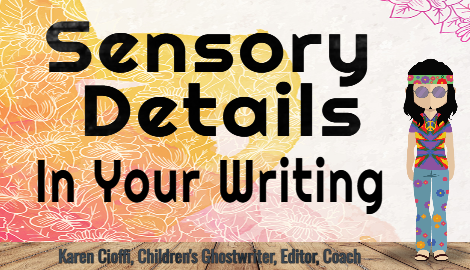Using sensory details in writing is a powerful technique that can help bring your words to life and immerse your readers in the world you're describing. Sensory details appeal to the five senses: sight, hearing, touch, taste, and smell. Incorporating these sensory elements into your writing can create a more vivid and engaging experience for your readers. Here are some tips on how to use sensory details effectively: 1. Show, don't tell: It’s all about showing rather than telling in writing. Instead of telling your readers that a room is cold, describe the icy draft that seeps through the cracks, making them shiver. Let the reader feel the cold; don't just inform them about it. Instead of saying, "It was a beautiful garden," describe the garden's vibrant flowers, lush greenery, and the play of sunlight. 2. Use descriptive language: Words are powerful, and using descriptive writing to paint a picture for the reader is even more powerful. Choose words and phrases that paint a clear picture in the reader's mind. Instead of saying a character is sad, describe how their eyes well up with tears, their voice trembles, and their shoulders slump. And specific details are more evocative than vague ones. Instead of saying a character heard a loud noise, describe it as a deafening crash or a thunderous roar. Word choices matter. Try to incorporate multiple senses in a single scene or description. For example, if you're describing a bustling street market, mention the colorful fruits and vegetables (sight), the vendors calling out their prices (sound), the aroma of spices in the air (smell), and the texture of the rough cobblestone streets (touch). Another example is to describe the taste of salt in the air by the sea, the feeling of the sand between toes, and the sound of crashing waves. We’ll discuss these senses a bit more below. 4. Use similes and metaphors: Comparing one sensory experience to another can help readers understand and visualize the sensations. For instance, "The coffee was as bitter as a heartache" uses the sense of taste to convey a feeling. Just be careful not to use cliches. You want to create unique metaphors. Carolyn Howard-Johnson suggests morphing adverbs into metaphors in her book, The Frugal Editor. 5. Consider the mood: Tailor your sensory details to the mood of your scene. If you're writing a tense moment, focus on the character's racing heartbeat and the way their palms sweat. If it's a serene scene, describe the gentle rustling of leaves and the sun’s warm caress. In addition to how your character’s mood is conveyed, different sensory descriptions can evoke different emotions in the reader. 6. Character perspectives: Different characters may notice different sensory details based on their personality, experiences, and emotions. A chef might focus on the aroma of a dish, while a detective might notice the subtle clues in a crime scene. Depending on the character’s enlightenment or awakening in a scene, he may, for the first time, notice the aroma of flowers he’s passed every day of his life. 7. Use sensory details to reveal character: What a character notices and how they react to sensory stimuli can provide insight into their personality and emotions. For example, a character who notices the beauty in small, ordinary things might be portrayed as more optimistic and appreciative. A character who perceives a slight infraction as an outright assault might have a chip on his shoulder, be unhappy, or just looking for trouble. 8. Avoid overloading: While sensory details can enhance your writing, be careful not to overwhelm your readers with a barrage of sensory information. Select the most relevant and impactful details for the scene. Now let’s go over the individual senses: Visual Imagery (Sight): Describe the scene in detail, including colors, shapes, and sizes. Auditory Imagery (Hearing): Describe the sounds in your setting or scene. You might use onomatopoeia (words that sound like what they represent) to create sound effects. This is especially useful in children’s writing. Tactile Imagery (Touch): Convey how things feel to the touch, whether it's the rough bark of a tree, the softness of a blanket, or the heat of a summer day. Describe the sensations characters experience when they touch something, such as a pinch, the warmth of a hug, or the firmness of a handshake. Gustatory Imagery (Taste): Use taste descriptions when relevant, especially in scenes involving food or drink. You might use sweet, bitter, salty, sour, oily, sharp, or zesty. Show characters' reactions to tastes, like a character savoring a delicious meal or grimacing at something bitter. Olfactory Imagery (Smell): Describe the scents in your environment, whether it's the aroma of a freshly baked pie, the pungent odor of dirty socks, or the salty sea breeze at the beach. Connect smells to memories or emotions to add depth to your writing. Revise and edit: As with all writing, after you’re done, review your work to ensure that the sensory details are well-integrated into the narrative and enhance the reader's experience rather than feeling forced. Summing It Up Incorporating sensory details into your writing can transform it from a dry narrative into a rich, immersive experience that captivates your readers and brings your story to life. Practice and experimentation will help you refine your skills in using sensory details effectively.

I’m a working children’s ghostwriter, editor, and coach. I can help turn your story into a book you’ll be proud to be the author of, one that’s publishable and marketable.
OTHER HELP I OFFER:
FICTION WRITING FOR CHILDREN COURSE
A guided self-study course and mentoring program.
HOW TO WRITE A CHILDREN’S FICTION BOOK
A DIY book to help you write your own children’s book.
WRITERS ON THE MOVE PRESS.
Self-publishing help for children’s authors.
You can contact me at: kcioffiventrice@gmail.com. Or give me a call at 347—834—6700. (Please leave a message- I’ll get back to you as soon as I can.)


1 thought on “Sensory Details In Your Writing”